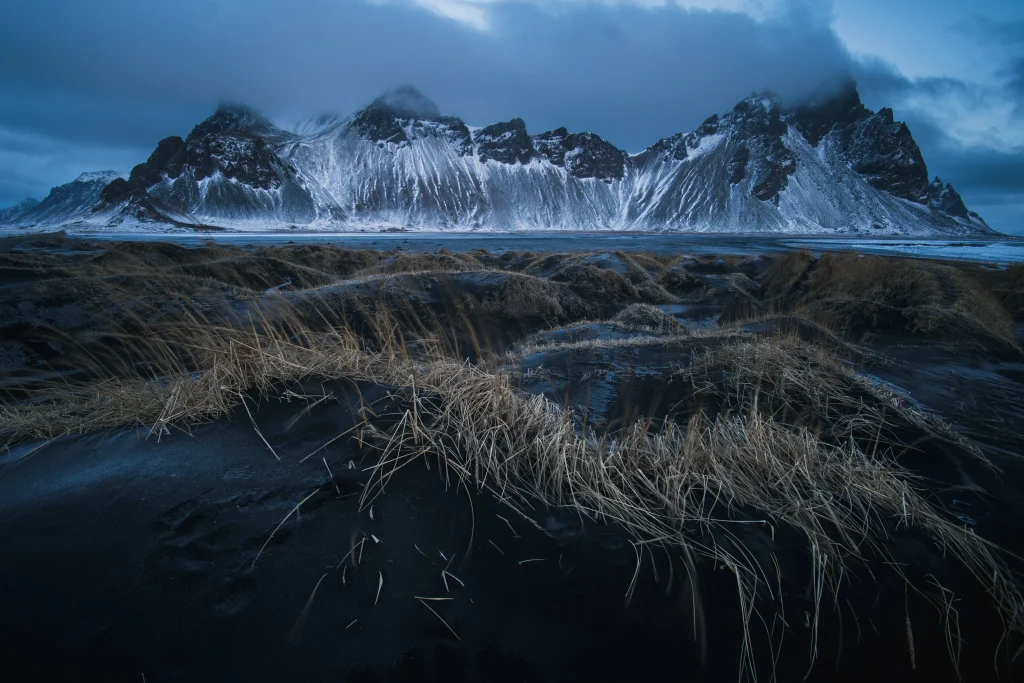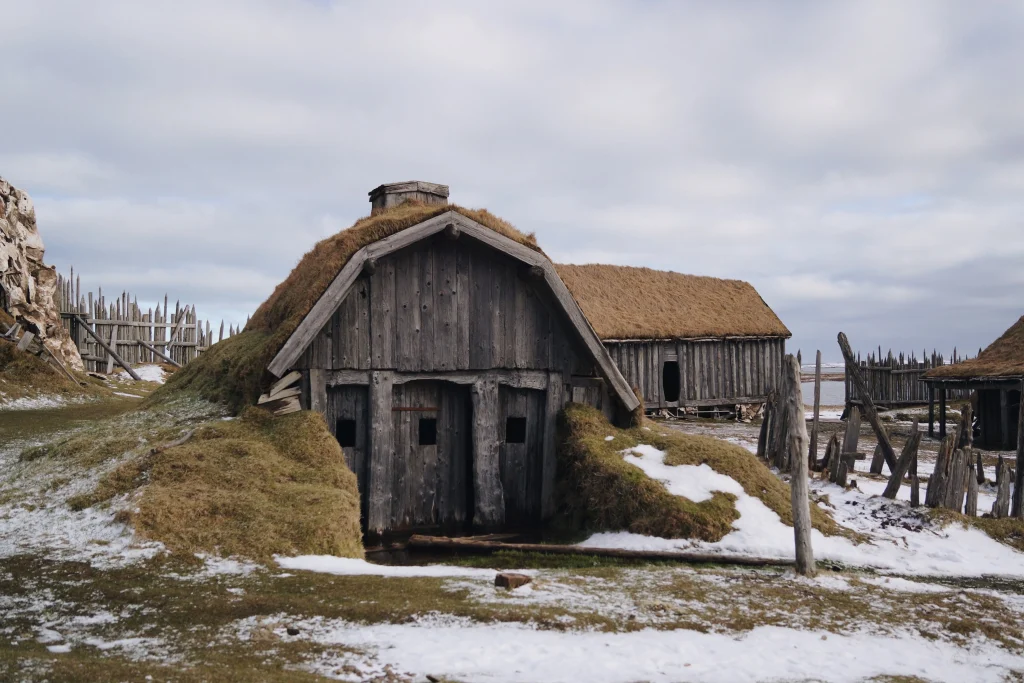The Stokksnes Peninsula is located on the east coast of Iceland and is a beautiful place surrounded by mountains, glaciers, and fjords. The landscape here is characterized by black sandy beaches lapped by the rugged sea. Majestic mountain peaks overlook the scenery, providing visitors with an unforgettable sight.
Vestrahorn
One of the most distinctive features of the peninsula is the Vestrahorn Mountain. Standing at a height of 454 meters, it majestically rises into the sky and is a popular destination for photographers from around the world. The mountain offers spectacular views of the surrounding landscapes and is a popular photographic subject at any time of the day.
In Iceland, one of the first settlement farms was built by Hrollaugur, the son of Count Rögnvaldur of Møre in Norway, and it was named Horn. The Hornafjörður municipality and several nature reserves were named after this settlement farm. “Horn” means the same in Icelandic and English.
The area is about a ten-minute drive from Höfn. The Horn area lies beneath Vestra-Horn and is an interesting geological site consisting of unlayered plutonic rock, mainly gabbro but also granophyre. East of the mountain, there’s a peculiarly shaped rock called Brunnhorn that stretches to the sea. Seals also like to hang out on the sandy strip, so with a bit of luck, you can capture a photo of a lazy seal.
During World War II, the Horn area became a base for the British Army, and later, a NATO radar station was established in Stokksnes, south of Horn. In Stokksnes, you can feel the power of the Atlantic Ocean as the waves crash against the rocky coastline.
Another highlight of the Stokksnes Peninsula is the Viking Cafe. This café is housed in a traditional Icelandic fishing house and offers visitors a unique opportunity to experience local cuisine and culture. Here, you can taste fresh fish and seafood and gain an authentic insight into life on the Icelandic coast.

If you wish to further explore the area, I recommend taking a trip to the nearby Vatnajökull National Park. Here, you can visit Europe’s largest glacier and engage in various hiking and outdoor activities. You can also take guided tours of the caves and glacier crevices, revealing the beauty of the glacier world.
In the vicinity of the Stokksnes Peninsula, there are several small villages and towns worth visiting. One of these towns is Höfn, a charming coastal town known for its top-notch restaurants and local cuisine. Here, you can try fresh seafood and fish specialties and relax in one of the many cozy cafés.
Overall, the Stokksnes Peninsula is a must-visit destination in Iceland. With its breathtaking landscapes, traditional fishing houses, and unique culture, it offers visitors an experience they will never forget.
The Viking Village
The Viking Village (Víkingaþorpið) at Stokksnes is a reconstruction project for a film set that began in 2010. It was developed to provide visitors with an authentic experience and tell the story of the Vikings in Iceland. The village consists of several houses built in the traditional Viking style, each equipped with artifacts and items dating back to the Viking age.

Almannaskarð
Almannaskarð is an old mountain road about 10 km east of Höfn. Nowadays, the southwest slope is closed to car traffic, as it was replaced by a 1300 m long tunnel under a mountain in 2005. Since then, the area has become a popular hiking trail for locals, and at the top of the road, there’s a magnificent viewpoint from which you can enjoy a panoramic view of the Hornafjörður region and the Vatnajökull Glacier on clear days. It’s a charming stop for those seeking the tranquility and natural beauty of the land.
Vatnajökull National Park
The Vatnajökull National Park was established in 2008, encompassing the Skaftafell and Jökulsárgljúfur national parks, as well as the Vatnajökull Glacier cap itself and extensive areas around it. Today, the Vatnajökull National Park covers 15% of Iceland.
The park is characterized by diversity in every aspect, be it landscape, biosphere, cultural remnants, or service levels. For simplicity, it can be divided into two categories: uninhabited highland areas with limited amenities and lowland areas.
The park’s visitor centers are all located in the lowland areas. Each of them features an exhibition on the park’s nature and cultural heritage. Each also has a souvenir shop with a special focus on local handicrafts and products.
In 2019, the Vatnajökull National Park was added to the UNESCO World Heritage List.
Visitor centers and other tourist information centers cooperating with the park provide information and services for the park and its immediate surroundings.
Höfn
Hornafjörður is a thriving municipality near Europe’s largest glacier, Vatnajökull, in the southeastern part of Iceland. The most densely populated area in the district is Höfn. In this region, you are at the foot of Vatnajökull, and the landscape is stunning. The Vatnajökull National Park, Europe’s largest national park, is located in the municipality. In recent decades, tourism has boomed and has indeed become a significant economic sector in the municipality. Various services are offered, including hotels, campsites, restaurants, shops, swimming pools, golf courses, marked hiking trails, and various museums such as a maritime museum, two visitor centers of the national park, and the center of the prominent writer Þórbergur Þórðarson.
Höfn’s growth in the 20th century, from a small village to today’s town, was the result of the development of a relatively diverse fishing industry. The catch is now more diverse than in other fishing towns, including high-value species like the Norwegian lobster, but a good portion of the Icelandic lobster catch is landed in Höfn. In recent years, the town has promoted lobster as a central element of its image, for example, with a “Lobster Festival” held every summer. Höfn actually means harbor, but repeated dredging was necessary to protect the harbor entrance from sand deposits.
Hoffell
Hoffell is an agricultural area characterized by a large outlet glacier named Hoffellsjökull and gabbro rock. The gabbro rock formed deep within the Earth but is visible in the area due to the uplift and glacial erosion in the vicinity, giving the otherwise dark rocks a greenish hue. The Hoffell area is located 15 kilometers from the town of Höfn.
Driving or hiking north from Hoffell while passing through the sands of Hoffellssandur, you can admire the spectacular landscape of the mountain slopes carved by past glaciers. Along the sands of Hoffellssandur, you can also visit a borehole designed for the extraction of geothermal water. Finally, you’ll reach the ice of the glacier tongue, Hoffellsjökull, surrounded by the numerous hiking trails of the Geitafell Mountain.
The area partially belongs to the Vatnajökull National Park, preserved for outdoor recreational activities and rich in vegetation, wildlife, and geological diversity. The region’s numerous hiking trails offer breathtaking views of the various beautiful wonders it has to offer.
The Glacier World offers a lovely guesthouse and geothermal baths in a stunning area surrounded by mountains and glaciers. Visiting the geothermal baths is a perfect way to enjoy the contrasts of Icelandic nature and have a great view of the Vatnajökull Glacier at the same time. You can relax in a hot, nurturing bath while soaking in the energy of the landscape.
Stokksnes, Vesturhorn, and the surrounding areas offer a rich blend of natural beauty, cultural experiences, and historical significance. From the towering Vestrahorn Mountain to the Viking Village, each aspect of this region tells a unique story of Iceland’s past and present.
Whether you’re a nature enthusiast, a photography enthusiast, or simply seeking a tranquil escape, the Stokksnes Peninsula and its surroundings have something to offer everyone. The Vatnajökull National Park, with its diverse landscapes and outdoor activities, is a must-visit destination for adventurers and explorers.
Hornafjörður, with its growing town of Höfn and its focus on Icelandic lobster, provides a taste of local culture and cuisine that you won’t want to miss. And if you venture further into the region, you’ll discover the natural wonders of Hoffell and its captivating geological features.
As you explore these areas, you’ll gain a deeper appreciation for the beauty and diversity of Iceland’s landscapes, making your visit an unforgettable experience.
No Comments Yet